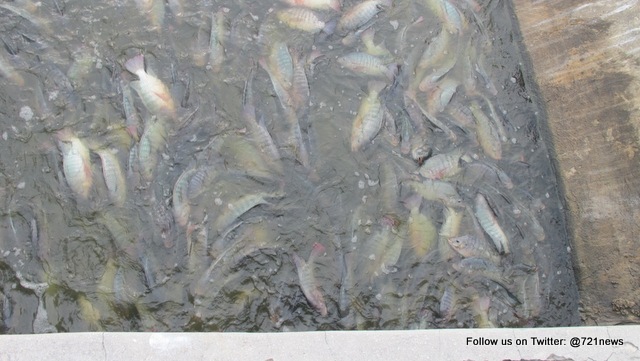The Nature Foundation carried out its bi-annual water quality tests on the 10th, 11th and 22nd of April (Earth Day) at seven sites surrounding St. Maarten. These tests are carried out in order to determine the levels of pollutants and other factors affecting wetlands and beaches on St. Maarten. Tests were carried out in order to determine Nitrates (which shows that the water is polluted), Phosphates (which shows the presence of Sewage), Nitrogen, Dissolved Oxygen, and the acidity of the water. Tests were carried out on seven sites; Cole Bay Lagoon, Simpson Bay Lagoon, Mullet Pond, Kim Sha Beach, Great Bay Beach, Belair Pond, Fresh Pond, and the Great Salt Pond. The sites of Great Bay Beach and Kim Sha Beach were particularly chosen to test the swimming quality of the beaches. Tests were also carried out as part of the Nature Foundation’s Earth Day Activities.
It was determined that Mullet Pond, and Great Bay had low levels of both phosphates and nitrates in samples tested. Elevated levels of nitrates and phosphates show that there is a presence of various types of pollutants and sewage in wetlands and coastal areas. The highest level was recorded in the Great Salt Pond and indicates lower water quality. Taking this into consideration levels will continuously be monitored by the Nature Foundation.
It was further established that Mullet Pond and Great Bay had low levels of Nitrogen in samples tested. Elevated levels of Nitrogen, caused by pollutants, can cause massive fish die-offs in wetlands and coastal areas. The highest level was recorded in the Great Salt Pond at .6 ppm, which is a relatively high number and indicates the presence of elevated nitrogen levels which can pose a threat to aquatic organisms and which may again result in fish die-offs. The continuous filling in of the Great Salt Pond, recently for will increase the level of fish die-offs in the future.
Similarly the Belair Pond has also been experiencing elevated levels which can result in a continuation or expansion of fish die-offs, of which a small scale die-off is currently occurring. All fish recorded at the die-off are Tilapia. The Nature Foundation will continuously monitor Nitrogen Levels at this site in order to give an approximation when fish die offs may be expected.
Some areas of the Simpson Bay Lagoon showed an increase in algal growth due changes in water movement and persistent hot and dry conditions. Continued filling in of the Simpson Bay Lagoon will also results in the growth of harmful algae unless management mechanisms are put in place.
The Nature Foundation also submitted recommendations to the VROMI Ministry on ways to combat the invasive Tilapia Population and how to rehabilitate the Great Salt and Fresh Ponds. Follow-up meetings will be held regarding this.




























